#Bus Companies Dublin
Explore tagged Tumblr posts
Text
Bus Hire Dublin
Express bus company provides transportation Facility services any type of Rental transport whether it's for corporate events, school outings, leisure trips, or special occasions like weddings or parties. When it comes to transporting larger groups of people, hiring a minibus or a bus can be an incredibly practical and cost-effective solution. Minibus and bus hire services offer a range of vehicles to cater to different group sizes and requirements, providing convenience, comfort, and reliability for various occasions.

Minibus and bus hire Express bus company typically employ experienced drivers who are well-versed in navigating various routes and ensuring passenger safety. These drivers undergo rigorous training and adhere to strict safety standards, providing passengers with peace of mind throughout their journey. Additionally, reputable hire services maintain their vehicles to the highest standards, conducting regular inspections and maintenance checks to ensure reliability and comfort for passengers in ensuring smooth and hassle-free travel experiences.
#Bus Hire Dublin#Minibus Hire Dublin#Coach Hire Dublin#Bus Quote Online#Bus Companies Dublin#Private Bus Hire#Minibus Hire Online Quote
0 notes
Text
Why Travel Coach Is Important While Travelling Long Distance?
If you have a match at some destination and you have to travel one day before, doesn’t it feel very tiring? Actually, it is tiring. As a human being, it is not possible to perform well in any activity if you are tired. That is why it is essential for you to travel in a comfortable vehicle where you can relax, take a nap and not be tired.
At Dundrum Coaches, we offer team travel coach hire service with a capacity of 33 people to 87 people as per your team size requirement. Our buses are designed to provide you with the utmost comfort with ample legroom and luggage capacity. We also provide you with professional and knowledgeable drivers who drive smoothly and have an idea of Dublin’s road.
In this blog, we will provide you with some information on why you should consider a team travel coach hire service to maintain the energy and comfort of your team.
Comfort: You can experience the best level of comfort with our travel coach as our seats are made with cushioned material so that you can sit there for a long time without any problem.
Safety:Our professional drivers take care of your safety and for emergencies our travel coaches are equipped withfirst-aid boxes and other safety equipment.
Space:Our coaches are designed to carry your luggage and provide ample legroom so that you can relax during your journey.
Cheaper way to travel: If you are traveling in team then it is a cheaper way to travel in comparison to other transportation modes.
Visit Dandrum Coaches to hire team travel coach to travel long distances with utmost comfort.
#team travel coach hire#Bus Hire For Golf Tours#Coach Hire Dublin#Dundrum Coach Hire#Bus Company Dublin#Affordable Coach Hire Ireland
0 notes
Text
Tips for Choosing the School Tour Bus Hire in Dublin
When planning a school tour or field trip in Dublin, one of the essential considerations is choosing the right school bus hire service in Dublin. The safety and comfort of the student should always be the top priority. To help you make an informed decision, we have compiled a list of tips for choosing the best school bus service.
Safety
Safety should be the foremost concern when selecting a school bus service. Ensure that company has a valid license and all necessary certifications.
Regulationandinspection: Verify the company adheres to all regulations regarding school bus hire. Look for evidence of regular safety inspection by the relevant authorities.
DriverQualifications: Don’t settle for anything less than experienced and qualified drivers. Ensure they possess valid PCV (Passenger Carrying Vehicle) licenses and have undergone training specifically for handling school groups.
InsuranceCoverage: Make sure the company offers comprehensive insurance that meets the standards set by regulatory bodies.
Comfort
BusAmenities: A comfortable journey enhances the entire experience. Look for buses with features like well-maintained, comfortable seating, air conditioning, and functional seat belts.
Extratouches: Consider amenities that can make the trip even more enjoyable. Features like Wi-Fi, onboard entertainment systems, or even reclining seats in larger coaches can be a big hit with students on longer journeys.
Planning and Communication
Matchingcapacity: Choosing the right size bus is important. We offer a variety of vehicles to suit your group size, ensuring everyone has enough space.
Sharingtheitinerary: Provide the bus hire company with a detailed itinerary in advance. This should include pick-up and drop-off locations, scheduled stops, and specific timing requirements.
Clearcommunication: Maintain open communication with the bus company throughout the planning process. Ask questions, voice any concerns, and ensure a smooth and stress-free experience.
Selecting the right school bus hire service in Dublin is important for a successful and enjoyable school trip. By following these tips, you can make an informed decision and provide a safe and comfortable transportation experience for your students. For reliable school bus hire service in Dublin, consider Express Bus, a reputable and trusted provider in the area.
#School Bus Hire Dublin#Best Minibus Hire Companies#Bus Hire Dublin#Private Bus Hire#Minibus Hire Coolmine#Minibus Hire Clonee#Double Decker Coach Bus Services#Wedding Bus Hire Dublin#Sports Team Bus Rentals
0 notes
Text
youtube
Happy Birthday Founding member of The Waterboys, Michael ‘Mike’ Scott born 14th December 1958 in Edinburgh.
Okay, I've been posting about the 15th, and only just noticed, I blame the copious anount of alcohol I consumed yeaterday....at least it leaves me free tomorrow as there is a football match on I want to watch.....here goes with todays posts.......
Scott was born and raised in Edinburgh. His father, Allan Scott, left the family when Mike was ten years old, but the two were reunited in 2007.
Scott was interested in music from an early age. At age 12, after the family had moved to Ayr, he began a serious interest in learning guitar. In 1968 he mentions listening to Hank Williams as a “life-changing” experience. The next year, Scott was playing in school bands and formed the band Karma, they were inspired by David Bowie, The Beatles and Bob Dylan.
Playing in a few bands by the time 1981 came he had started the idea of The Waterboys, he admits that he “is” The Waterboys, the lineup has changed through the years but he say that “ there’s no difference between Mike Scott and the Waterboys; they both mean the same thing. They mean myself and whoever are my current travelling musical companions.”
It’s not all about having hits with The Waterboys, Mike is a natural songwriter, as The Waterboys and Mike Scott he has released 15 albums, 4 of the singles reached the top 40.
In mid-1980s, when The Waterboys supported U2 at Wembley Arena in London, Mike Scott’s band seemed all set for the same global status as Bono and Co.
The following year, when their third album, This Is The Sea, and classic single, The Whole Of The Moon, catapulted the band’s “big music” into the Top 10 such success seemed virtually assured. But it was never what he wanted. Under pressure from his record company to produce more stadium-pleasing Waterboys tracks, he retreated to Ireland… and made a folk record. Mike has lived in the Fair city of Dublin for over 12 years and holds a dual nationality, he said in an interview last year “ ....people have often told me I’m an honouree Irishman, but I feel Scottish. But I’m very proud to live in Ireland. And my children are Irish. So, now I’ve very deep roots here.”
Mike continues to write and tour with the Waterboys, I remember always arguing with a friend that disagreed with me that the Waterboys were (are) a Scottish group, it’s true some of the members of the group have come from Ireland and England as well as the US but Mike Scott, as I said to him and would still say to him IS The Waterboys, The Whole of the Moon is a top class song and the lyric…
“Unicorns and cannonballs, palaces and piers
Trumpets, towers and tenements
Wide oceans full of tears
Flags, rags ferryboats
Scimitars and scarves”
……could only be written by a Scotsman. The song was initially released to a limited success in 1985, it resurfaced again in 1991 and won an Ivor Novello Award as “Best Song Musically and Lyrically” that year and reached number 3. Celtic Women sing a version at their concerts, Jennifer Warnes has also covered it as well as the late great Prince at Ronnie Scott’s Jazz Club during his 2014 Hit & Run tour. U2 used the song as a “walk out tune” during the Joshua Tree tour.
I’ve chosen another song, this is a solo track by Mike, I think you’ll like it, especially if you are from oor capital city.....the song is a live rendition at Kelvingrove Bandstand in Glasgow with The Waterboys.
Edinburgh Man
I woke up in the morning
Seven twenty-four
Drank a cup of coffee
Stepped out the door
I said Goodbye
To my old best friend
I took a ride
To the old West End
I walked along Princes Street
My feet were hurting bad
As I squirmed inside my shoes
I was thinking about my dad
There was the bones of a song
Beatin' around my head
Unless I remember it wrong
This is what it said:
Edinburgh Castle hugging the sky
Cold grey stone, humourless and dry
Sitting like a cork on top of the town
One of these days I'm gonna blow you down
I jumped on a bus
A trusty number 23
To the Royal Botanical Gardens
Where a ghost was calling me
I saw a brace of weeping willows
A burnt and withered land
I saw a man and a little boy
Holding hands
I scanned the skyline
It was like the backdrop of a play
I never saw your heartless beauty
Until I'd been away
As I was climbing up The mound
It struck me like a chime
I must have dreamed this scene
About a thousand times !
Edinburgh Castle hugging the sky
Cold grey stone, humourless and dry
Sitting like a cork on top of the town
One of these days I'm gonna blow you down
I found myself on Forrest Road
Feeling pretty sore
This city once was mine
But it ain't mine anymore
And here's my old school, "Jingling Geordie's"
And I must confess
I couldn't step through that gate
Until I'm better dressed
Back at Waverly Station
Half dead on my feet
I got on board the four forty-four
Promptly fell asleep
I woke up in Queen Street
At my journey's end
I've got to say it's totally great
To be back in Glasgow again !
Edinburgh Castle hugging the sky
Cold grey stone, humourless and dry
Sitting like a cork on top of my town
One of these days I'm gonna blow you down
6 notes
·
View notes
Text
Week 1: Planes, Trains, and Automobiles (+ a Ferry)
Ciao!
In the past week, I have used Italian trains, buses, taxis, a shuttle van, planes, and taken a ferry ride, so this blog post will be dedicated to transportation.
To begin, I was supposed to fly from Chicago to Dublin, then Dublin to Naples, where CIS Abroad (the company hosting the program) provided transport shuttles to either the dorms or shared apartment accommodations in Sorrento. The initial long-haul flight wasn’t too bad, I read for the majority of the flight and was fed some half-decent food.
Unfortunately, due to delays on the tarmac in Chicago, I missed my connecting flight in Dublin and had to figure out another way to Naples. I luckily discovered someone else also in my program in my same flight and we navigated Europe together. Since the next flight out to Naples wasn’t until the following evening, we decided to go instead to Rome and then brave the Italian train system to navigate to Naples.

(Me and a fellow study abroad student taking a shuttle to our new terminal in Dublin)
To preface, figuring out the train system seemed to be one of the biggest learning curves people that I have talked to have encountered in the past, and as such it was something I was nervous about coming to Italy. Trains (and ferries, as it turns out) are frequently late and don’t align with posted schedules, tickets have to not only be bought but also validated at the station, and the platform numbers commonly change right before arrival. We were supposed to be briefed on how to handle it during our orientation the first day, however we were thrown straight in the deep end! We used one of the most common websites for booking high-speed trains, ItaliaRail, and managed to book a train from the Rome airport to the main Roman train station (surprisingly far from the airport), then one from Rome to Naples for a total cost of around 65 euros.

(Red passenger train with volcano in background)
Since the first train was a regional/local train, there were no assigned seats and thus we had to validate our tickets just before boarding through, however for the high speed cross-country train to Naples, since we had an assigned seat, we did not have to validate (something that stressed us out as you can face fines if you don’t properly validate tickets). Thankfully, everyone we talked to was very nice and helped us figure it out.
Once in Naples, we shared a taxi to the airport with two other travelers we met along the way (5 euros each) and waited until a few others from the program landed and got the last transfer shuttle to Sorrento. Finally, after over 36 hours of traveling (almost 16 more than intended) we arrive with a leg up on the local transport compared to our peers.
Just earlier today, I took a bus with two other friends from Sorrento to Positano, another town along the Almalfi coast, for 10 euros. Getting the ticket was very easy, as the ticket booth at the bus station was clearly marked. The bus was about 30 minutes late, but that is to be expected for Italian buses. After around 45 minutes and many many curvy and windy roads, we got off at Positano and explored the town. On the way back, we bought ferry tickets for 19 euros (cheaper with cash than online) and waited in a long line to board. As with the bus, the ferry was quite late, but actually took less time to get back to Sorrento. I think the ferry is my new favorite form of transportation as I loved sitting on the top deck and watching the coastline go by.

(view of Sorrentine peninsula from top deck of ferry)
Overall, I am quite proud of myself for figuring out how to get around on the fly, but I definitely took away some important lessons. First, be patient, both with yourself and the transportation. Everyone gets lost/confused sometimes and navigating a new country is daunting. Be willing to ask for help if you don’t know what to do! It’s better than facing fines or unknowingly breaking any transit laws. Additionally, some places only take cash, make sure to always carry some cash! Lastly, if you can, TAKE DRAMAMINE, especially for the buses. I am not one to get car/motion sick, but the switch backs and coastal curves are no joke and all three of us were very close to turning green by the time we got off the bus.
This post is getting long, but I wanted to share some details of Italian public transportation as that was one of my biggest questions going into this program.
See you next week!
Marika Ruppart
Mechanical Engineering
Engineering in Sorrento, Italy
2 notes
·
View notes
Text
23 June 2023
The Sea of Blood
Gallipoli 23 June 2023
The Turkish flag is crimson red, with a crescent moon and a star emblazoned upon it. The meanings of the star and moon aren’t relevant here - it’s the choice of red. It represents the sea of blood that was shed for Turkish independence.
On V Beach, on the 25th of April 1915, the men of the Royal Dublin and Royal Munster Fusiliers (plus two companies of the Hampshires) spilled out of the deliberately beached collier River Clyde into a storm of Turkish rifle fire. The scale of death amongst the Irishmen (like their Lancastrian comrades over on W Beach) was such that the ocean was stained red.
Ireland, Great Britain and Turkey are all very different cultures, but in the flag of a nation and the sea of an Aegean shore, they all bleed the same.
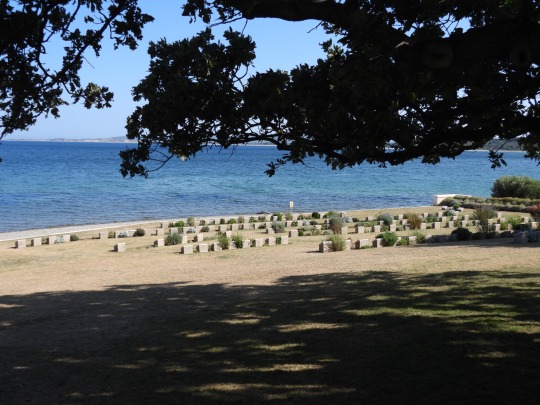
We started today at 8.30, catching the bus to the Beach Cemetary just beyond Ari Burnu, on the south end of Anzac Cove. Here we discussed the famed landing of 25 April - what we know of it, and what we know of it. The image of Anzac is a contested landing under withering fire, as reported in the war correspondant Ellis Ashmead-Bartlett’s dispatch. In fact, Ashmead-Bartlett was at sea on the 25th, and his report relied on second-hand information and some healthy artistic license - aside from at the Fisherman’s Hut to the north, the Anzac landing was largely uncontested. It was not until the ridges that the battle really began. Yet that contested landing is an integral part of Anzac lore, even after all the research that proves it mostly didn’t happen, and I think that’s because it’s such a heroic image - our version of Napoleon personally leading his men across the bridge at Arcole. Pre-dawn fighting also, of course, fits in with our dawn services - although I think the validity of the dawn service remains, as, contested or not, they did land at dawn.
We also stopped at Ari Burnu, where Ataturk’s (alleged) words are emblazoned upon a stone monument in front of the endless sapphire sea. We have a Turkish guide with us - that’s required by Turkish law, although she and my professor go back a long way - and she got me thinking a bit. Ataturk probably didn’t say those words, but as she said, does it really matter? Is the spirit more important than the historical authenticity? I don’t really have an answer to that. The historian in me says it absolutely does, but the citizen of the world in me says it doesn’t. (You may have heard the saying ‘inside me there are two wolves.’ Well, inside me there are two old white men.)

We went from there to Johnson’s Jolly on the Second Ridge, where we explored the old trench lines that have been rediscovered by battlefield archeology. It was here that I became the most recent casualty of the Gallipoli campaign, because I fell into one of the trenches. My only injury was a very slight wound on my arm, but I’ve got a sense of pride in being the last person (for maybe a day or two) ever to be wounded at Gallipoli. From Johnson’s Jolly (named after an artillery officer who would ‘jolly up’ the Turks with his battery’s fire - black humour was and is an intergral part of military life - we headed down Shrapnel Gully (again - there’s more than one path through it) to the 4th Battalion Parade Ground Cemetary. As the name suggests, most of the men buried here are of the 4th Battalion, largely made of New South Wales men, but there were a smattering of other men from the 1st Brigade, a few New Zealanders, and some men of the Royal Naval Division. We’ll talk about them at a later date, I promise.
We continued on after a brief interrogation of the Parade Ground, stopping to look over Monash Valley. Brigadier John Monash commanded the 4th Brigade, which consisted of men from all states. Monash was by all accounts a fairly mediocre brigadier, and at Gallipoli he’s most known for getting his brigade lost during the attack on Hill 971; he was eventually promoted, of course, and became a first-class corps commander in 1918. Looking over the terrain, I wonder if critics of Monash’s performance as a brigade commander are being too harsh - the distances at Gallipoli are tiny as the crow flies, but men, of course, do not fly. They have to navigate rough and unforgiving terrain, to climb and descend steep hills, often where no paths exist. It was inevitable that confusion would reign supreme.
Everything I learn of Gallipoli blackens my opinion of the entire concept of the campaign.

We ended our trek at Shrapnel Gully Cemetary, where we remained for a while to examine the graves there. By now the heat of the day was really setting in, and we returned to the hotel to wait it out. I ate noodles for lunch. I have no idea what kind, but I enjoyed them. Then I rested - I’m reading Gary Sheffield’s Short History of the First World War to reorient myself on the course of the war, and I quite like it.
At 5pm, we reassembled at the bus and headed down to Cape Helles. If one looks at a mapo, they can see that Gallipoli resembles a bare shoe, gingerly poking its toe into the Aegean. Helles is essentially the toe. This was the British and French sector - although Australian battalions did go to Helles, and British troops did fight at Anzac, so it was never quite so simple.

Our first stop was V Beach - one of five beaches attacked by the British in this sector. I think looking over V Beach today was the first time I experienced a really strong emotional connection on the tour - despite the modern boats and new buildings in Sedd el Bahr, the contours of the beach are almost exactly as they were in 1915. It looked almost like a colourised version of one of the pictures taken from almost our exact position after the landing. In my mind’s eye, I could picture the River Clyde - the Trojan Horse collier serving as a landing barge - beached in the shallow water, the scores of doomed men trying to clamber out, the few survivors huddling in the shallow shingle at the end of the small beach, and that blood red sea. I did not imagine the sound or the smell - I do not think such a thing could be imagined. I did feel a distinct lump in my throat, though, and a sense of disgust at the waste that happened here.
The British Memorial at Helles overlooks V - to the west, you can just about see W Beach (or Lancashire Landing), and if I had climbed the tower I’m certain I could have overlooked X and Y to the north, and S to the east. One of the great absurdities of Helles is that the landings at S and Y went off without a hitch, but they were starved of reinforcements as Generals Hamilton and Alymer Hunter-Weston dispatched their reserves to X, W and V. This is a cardinal military sin - you reinforce success, not failure. Yet in the grand scheme of things, it would have made little difference. Having more men at Y Beach (the British troops there called it ‘Why Beach,’ as they had no idea why they were there) wouldn’t have enabled the Allies to advance rapidly on the Dardanelles. Gallipoli does not smile upon rapidity.

We moved on to the Turkish Memorial. For legal reasons I can’t give my full opinions on this, but I can describe the structure. It’s almost like a flattened arch (and indeed, was meant to be a modernised Roman arch), the Turkish flag emblazoned on the roof. Ataturk had once said that a memorial as high as forty meters would not be enough to properly commemorate the dead of Gallipoli - so fittingly, this memorial is forty-one meters tall. The Turkish defenders are listed on surrogate graves around it, their names etched on red glass. It’s an evocative image, especially in the evening sunlight. There’s also at least three statues of Ataturk on the precint and I probably missed some, which gives you a very good idea of just how central he is to the Turkish story of Gallipoli.
We also noted here that of all the nationalities that fought at Gallipoli, only one is not commemorated here. I’m actually not going to tell you what that is - I want you to guess.
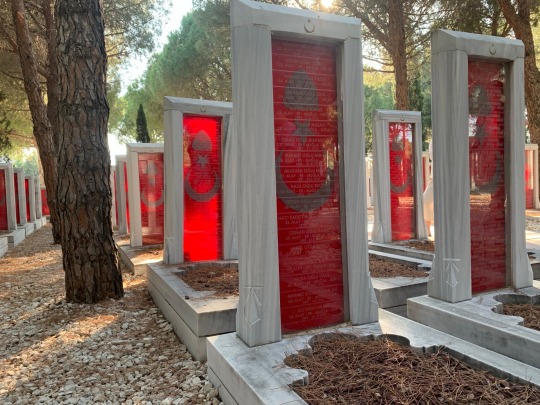
We continued to the French memorial - or perhaps French-led memorial is a better term. The French names are attached to catholic crosses very poorly disguised as the fleur-de-lys to provide plausible deniability to the Turks, who generally don’t like big, visible crosses on their land. I say French-led because a great many of these men are actually Senegalese - men recruited from the French colonial empire in Africa. Many of these men were appallingly treated and wasted on the battlefield - to say nothing of what became of them when captured by the Germans. Their rewards were anonymous graves, with no effort to mark their religious beliefs, and almost certainly no benefits from the state for the families they left behind. Even the Indians in British service got the basic decency of having their faith marked on their gravestones - no such luck for the Senegalese.
We ended the day near Krithia, the scene of three useless slogging matches fought in April, May and June to capture the heights at Achi Baba. This land is much flatter and more open than Anzac, but there are lots of ridges and rises that aren’t immediately obvious. The Ottoman forces, like Wellington before them, clung to these positions, and the British, French and Anzacs took heavy casualties in their fruitless attempts to dislodge them. Even the Third Battle of Krithia, which was deliberately smaller in scale and in which one corps actually managed to take their objective, came undone when Hunter-Weston insisted on spending his reserves on failing attacks in other sectors, allowing the Turks to regroup and retake their positions.
In case you’re feeling too sorry for old Hunter-Bunter by the way, he once referred to heavy casualties suffered by one of his battalions as ‘bloodying the pups.’ He was, and I hope you will excuse my vernacular, an absolute fuckwit.
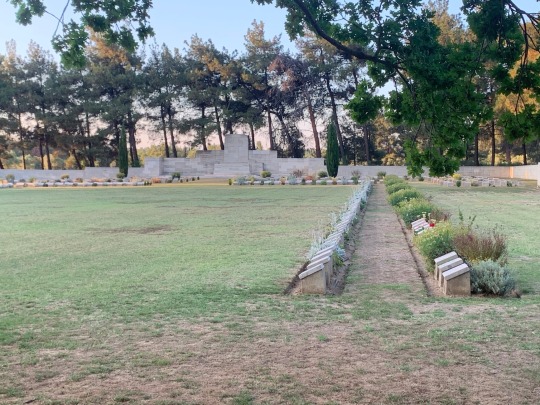
The Redoubt Cemetary is a little way south of that unassailable town of Krithia, and is a testament to stubborn endurance in the face of all sanity. In particular there are a lot of men who died on that last June attack, the ‘limited’ offensive - Manchesters, Royal Lancastrian Fusiliers, Marines and sailors of the RND, Leicesters and Cameronians and Sikhs and Royal Scots. Amongst these proud and distinguished old regiments are men from Australian and New Zealand battalions, killed in the attempt to support the British 29th Division at the Second Battle of Krithia. Accounts by their British allies record the bravery of these men under fire, painting the very image of Anzac - except, of course, their attack had been planned in about thirty minutes, and they never came anywhere close to their objectives. Men were mown down like wheat before a scythe - my professor’s words. Some were burned alive as bullets set off their ammunition, while others were disemboweled by machine gun fire.
There’s a very clean painting by Charles Wheeler in the AWM depicting the moment the Second Brigade advances, their Brigadier, Jim McCay, fearlessly urging them on while exposing himself to fire. It sanitises the slaughter that follows. It also doesn’t tell us that McCay, that glorious Victorian image of military heroism, was detested by his men for sending them into that battle. (McCay will be back, unfortunately - he’s proof that the ‘donkeys’ were not just British.)

We left the British sector at around 8.30pm, and drove alongside a beautiful red sunset back to the hotel. At this point, I’d be remiss not to mention Maddi, one of our student helpers. I tend to mention the really dramatic stuff and leave out all the little administrative things that tend to go wrong. When these things happen - like some idiot falling into a trench, for example - she’s been consistently on the case. She’s one of only two helpers responsible for handling twenty-eight university students, which is like herding cats, except the cats tend to be more organised. She has been doing an absolutely superhuman job at it, and I can say with confidence that none of this would be possible without her.
Well, that concludes Day Two in Gallipoli. Tomorrow, we’ll visit two of the most evocative sites in the memory of Gallipoli - Lone Pine in the morning, and in the evening, the Nek.
2 notes
·
View notes
Text
Traffic Management in Dublin: Navigating a Bustling City
Effective traffic management is crucial for ensuring the city’s roads remain safe and efficient. This blog focuses on traffic management solutions in Dublin and their impact on daily life.
Traffic Challenges in Dublin
Congestion: High vehicle volumes during peak hours lead to delays.
Construction: Ongoing infrastructure projects disrupt normal traffic flow.
Tourism: Seasonal spikes in visitors add pressure to road networks.
Pedestrian and Cyclist Safety: Increasing numbers of pedestrians and cyclists require dedicated measures.
Traffic Management Solutions in Dublin
Smart Traffic Lights: Adaptive systems that adjust timings based on real-time conditions.
Cycle Lanes: Expanding dedicated lanes to encourage sustainable transportation.
Public Transport Integration: Enhancing bus and tram services to reduce car dependency.
Parking Management: Implementing smart parking solutions to ease congestion.
Event Planning: Coordinating traffic flow during large-scale events like concerts and parades.
Importance of Traffic Management in Dublin
Safety: Protects all road users, including vulnerable groups.
Efficiency: Reduces travel time and fuel consumption.
Economic Impact: Smooth traffic flow supports local businesses.
Environmental Benefits: Lower emissions through reduced idling and better route planning.
Role of Technology in Dublin’s Traffic Management
GPS Monitoring: Real-time tracking for traffic updates.
Apps and Alerts: Providing drivers with live updates on road conditions.
Data Analytics: Using traffic data to plan future improvements.
Stakeholder Collaboration
Effective traffic management in Dublin requires collaboration between government agencies, private companies, and the public. Initiatives like public consultations and pilot programs help create inclusive solutions.
Conclusion
Traffic management in Dublin is a dynamic and ongoing process. By embracing innovative solutions and fostering collaboration, the city can overcome its traffic challenges and continue to thrive as a hub for culture, commerce, and community. With proactive measures, Dublin’s roads can remain safe and efficient for all.
0 notes
Text
Missed my “introduction to company” hr meeting becos the bus took 4.1 hours instead of 3 and the guy beside us was unresponsive for like a minute and all i could think of was aint no way im watching someone die in a dublin express bus in the middle of traffic while texting my manager
He woke up and puked two time after that btw
The smell was present
0 notes
Text
Offline Marketing Dublin | Quicklinks Ltd
Offline marketing in Dublin, like in many other cities, revolves around promoting businesses and services through traditional, non-digital channels. Here are some common strategies for offline marketing that are particularly relevant for businesses in Dublin:
1. Print Advertising
Local Newspapers and Magazines: Dublin has a range of local publications where businesses can advertise. Some examples include The Dublin Gazette, Irish Times, and Hot Press (for music and entertainment-related businesses).
Flyers and Posters: Distributing flyers in strategic areas like universities (Trinity College, University College Dublin), shopping districts (Grafton Street, Henry Street), and events can help gain local attention.
2. Billboards and Outdoor Advertising
Billboards and Banners: Large outdoor spaces in high-traffic areas (e.g., Dublin City Centre, Temple Bar) offer great exposure. JCDecaux and Clear Channel are two major outdoor advertising companies in Dublin.
Bus and Tram Ads: Dublin's public transportation, including Dublin Bus and the Luas (tram system), offer ad space on vehicles or at stops, targeting commuters.
3. Sponsorships and Events
Local Events Sponsorship: Sponsoring local events like music festivals (Electric Picnic, Longitude), sports (Dublin GAA games, rugby), or cultural events (St. Patrick’s Day, Dublin Theatre Festival) can create brand visibility.
Community Engagement: Participating in or organizing community events can boost brand recognition and foster goodwill.
4. Networking and Word of Mouth
Networking Events: Dublin has a vibrant business community with events like Dublin Chamber meetings, start-up meetups, and conferences that are great for word-of-mouth marketing.
Referral Programs: Encouraging existing customers to recommend your business in exchange for discounts or rewards can be very effective.
5. Direct Mail
Postcards, Catalogs, and Brochures: Sending physical mail to potential customers in certain postal areas (targeting demographics or locations) is another form of offline marketing. Dublin has several services for direct mail distribution.
6. Promotional Merchandise
Branded Giveaways: Distributing branded merchandise such as pens, tote bags, or keychains at public events, trade fairs, or through local stores can increase brand awareness.
These strategies can help businesses in Dublin increase visibility and customer engagement through traditional marketing channels.
0 notes
Text
Ireland, Part 2: July 16-19, 2024
After the initial panic of driving on the narrow roadways and the thrill of getting engaged, the rest of the trip was spent mostly enjoying each other's company and driving to various places in the southwestern part of the country.
On the 16th, we went on a tour of the Dingle Peninsula by bus, partly because I wanted a break from driving, but also because the Dingle Peninsula looked like it might be especially terrifying to drive around (and, based on my experience as a passenger on the bus, I was correct). Our guide and driver was an affable elderly gentleman who grew up on the Dingle Peninsula so long ago he remembered not having a telephone in the house, and when the first person in town got a television. The scenery throughout the tour was epic. We saw where the initial Rey/Luke scenes from The Last Jedi were filmed (the scene with the porgs!). We also saw lots of high cliffs and beautiful views of islands off the coast. And of course, we took lots of happily-engaged-schmoopy selfies.
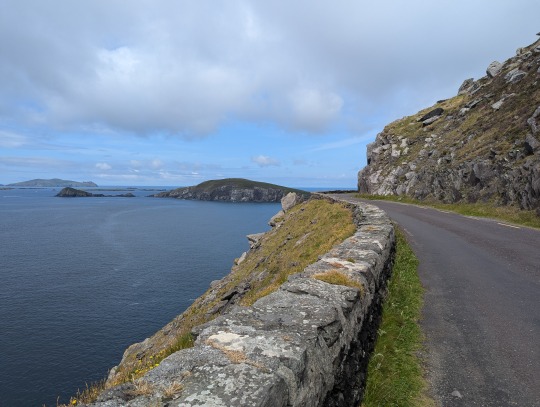
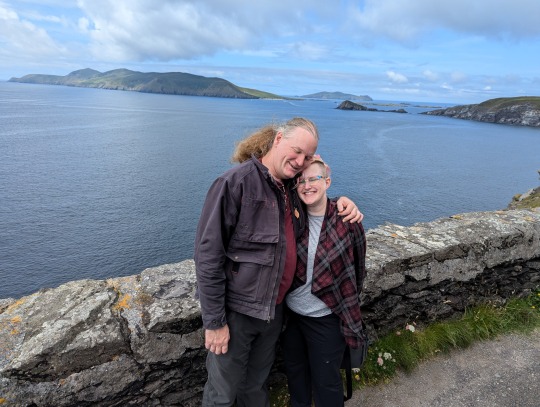
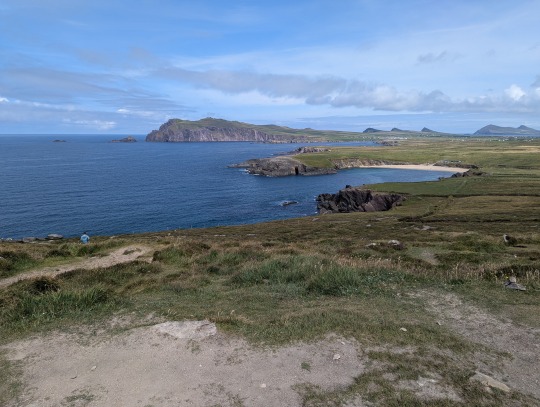
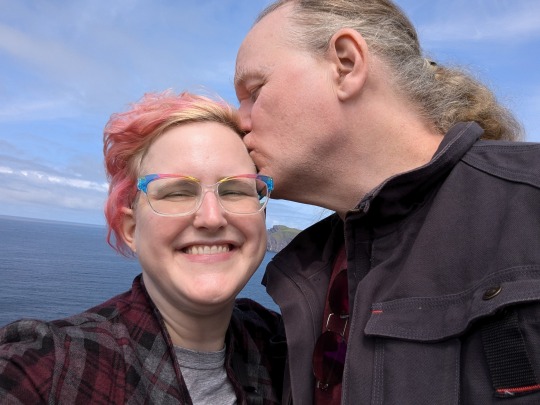
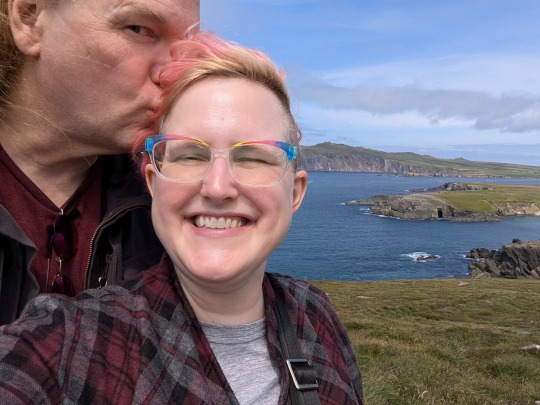
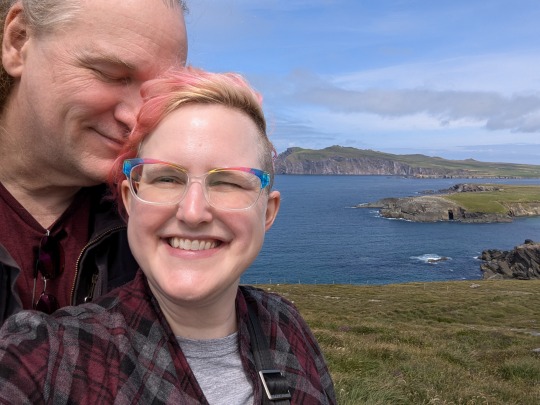
During our stop in Dingle, we did a bit of frantic ring shopping (didn't find anything, but we did get my ring size and on the bus ride back I found a ring I liked on Etsy, so Niall was able to order it). We also saw this very confusing establishment that's simultaneously a bar, bike shop, and hardware store.
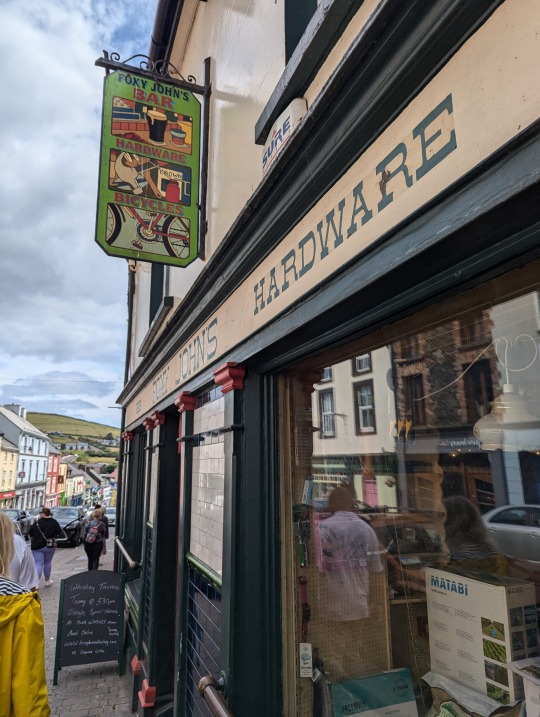
Dingle is also noted for being the home of Murphy's Ice Cream, which had a store in Kilarney we visited several times during our stay. Their ice cream was phenomenal, especially the raspberry sorbet, which was easily the best either of us had ever tasted. The website notes the ice cream is "handmade in Dingle" which gave us a lot of giggles about eating "handmade Dingle cream."

The latest Adventure in Doing Laundry was probably the simplest - we visited Speed Queen, a laundromat built into a gas station. Being a fan of the song of the same name by Thunderpussy, I had to get a selfie with the sign.
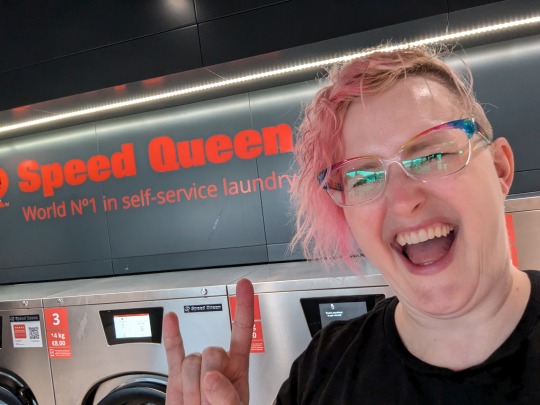
One of our remaining days was spent road tripping to the Limerick metro area, where we visited Bunratty Castle and Folk Park, where they had thatched-roof houses, elaborate faerie gardens, and some pretty fantastic shopping. We also had some delicious scones with clotted cream while chickens and a turkey wandered around our feet, which was whimsical AF. I highly recommend it as a tourist stop, especially if you have kids with you. It's easy to spend hours there.
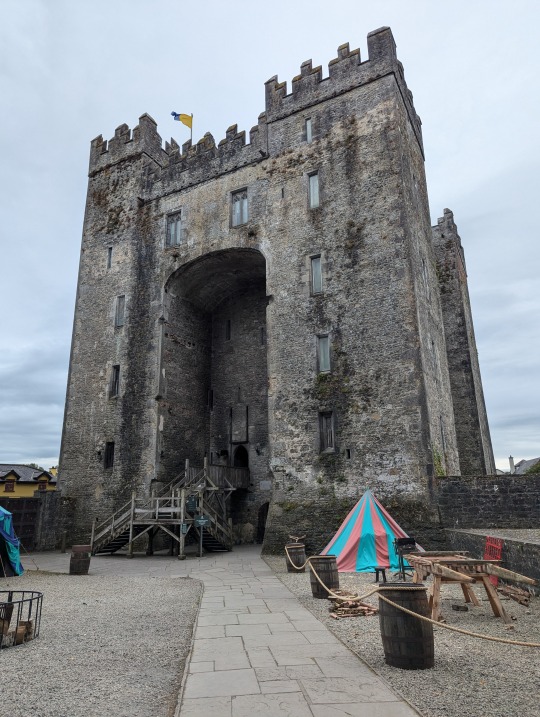
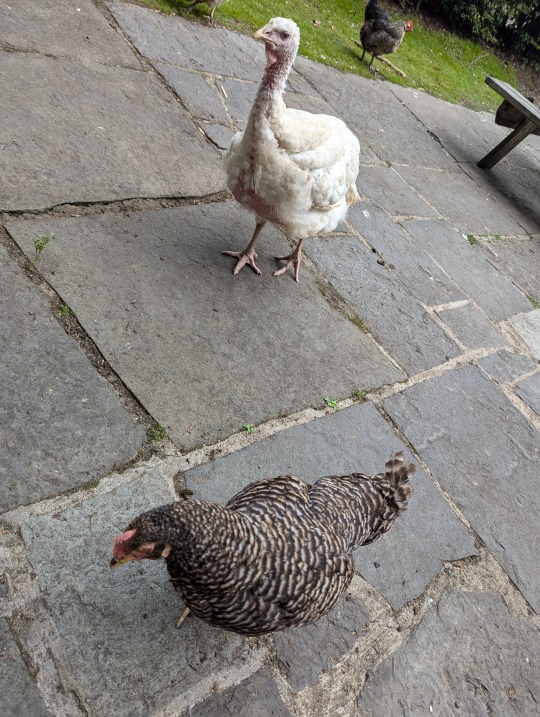
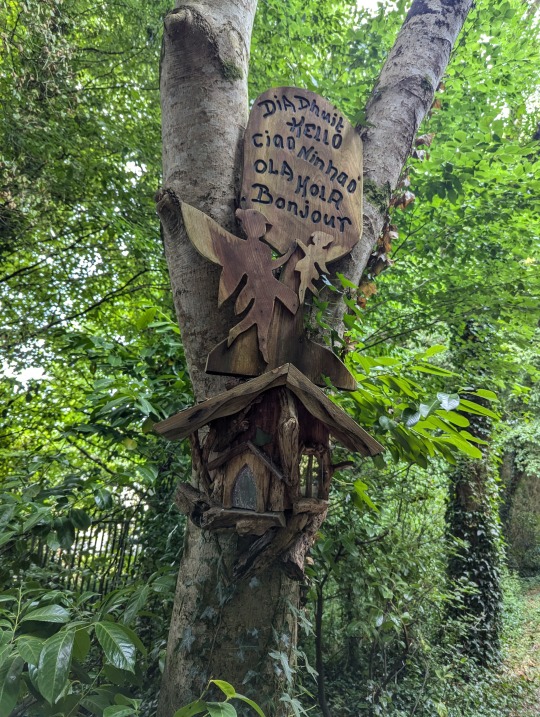
On the way home, we visited Grange Stone Circle, which is the largest stone circle in the EU. We had to wait for the landowner to move his cattle before we could get in, and one of the cows was curious about us and kept trying to nuzzle me over the fence, so that was cute.

We spent our last full day in Ireland hiking around Kilarney National Forest again, and this time we saw at least a dozen deer; running errands; packing; resting; and then celebrating our engagement with an astonishingly delicious dinner at Rozzers Restaurant, which is part of our B&B. I had local mackerel as a first course, some incredibly buttery and tender lamb for my main course, and a trio of sorbets (blackcurrant, whiet peach, and pineapple) for dessert, which was followed by petits fours. There was an absolutely gorgeous sunset that evening, too.
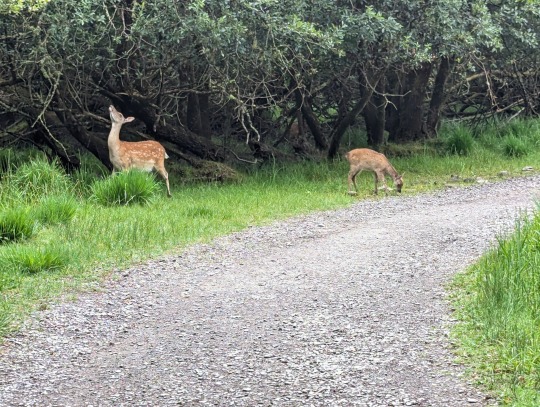
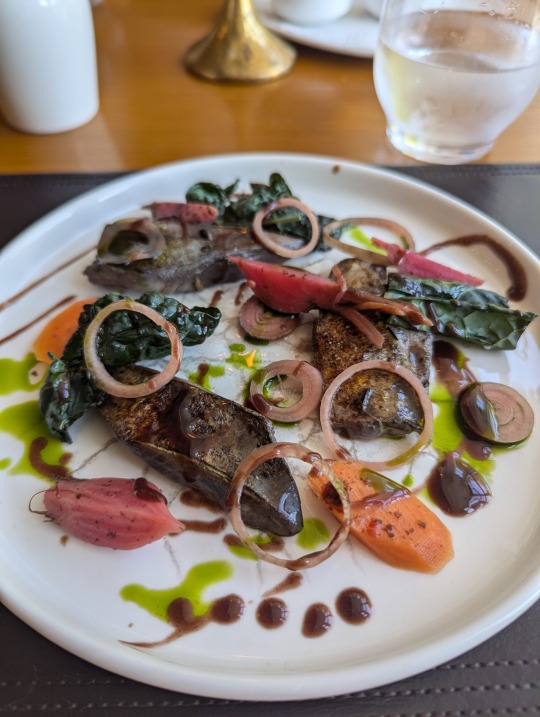

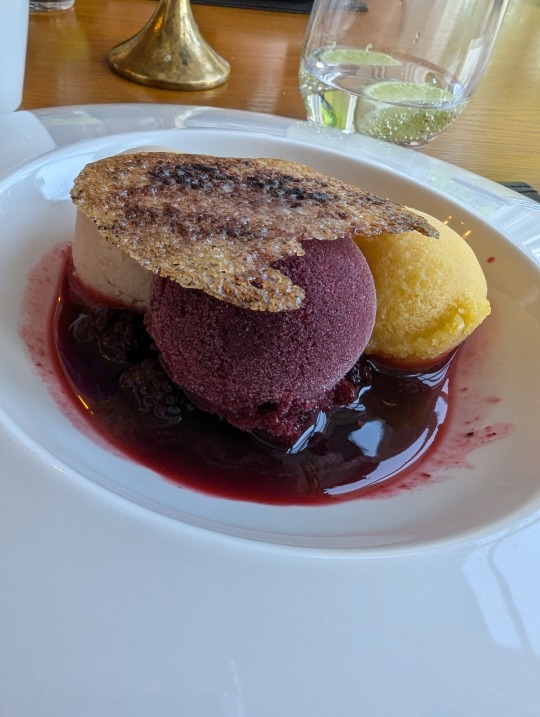
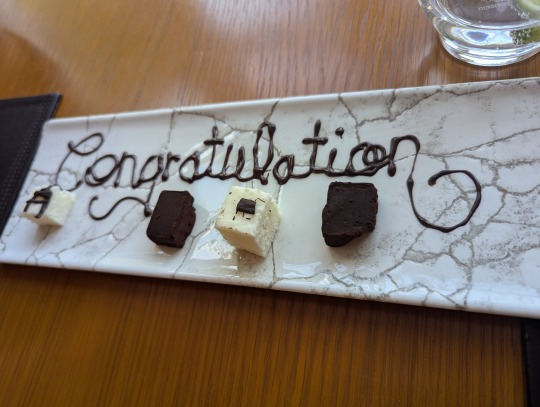
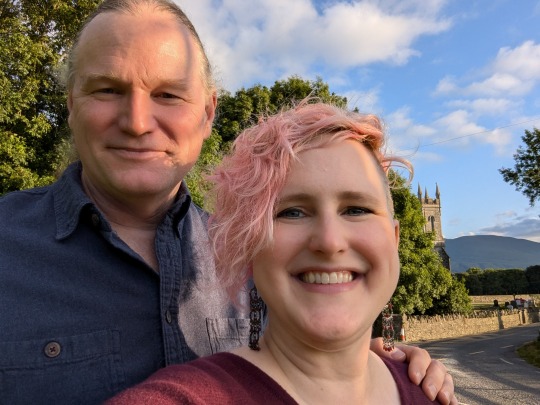
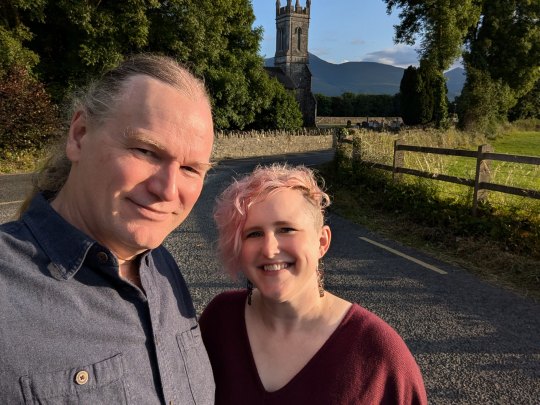
Our drive back to the airport, while long, was a lot less fraught than our initial drive to the B&B, since I was more experienced with the roadways and the vast majority of the trip was highways.
We managed to fly on the day of the big Crowdstrike/Microsoft incident, though, which made for a long wait in the queue to check in (the self-check-in machines were all down) and some slight delays in our flights. The nice thing was that because we waited in line and spoke to an agent, she was able to put us on an earlier flight to London, which gave us both more time to make our connections from there and a shorter wait in the Dublin airport. During our short stay in the airport, though, I finally tried some Butler's Chocolate - both in hot chocolate form and an individual chocolate candy - and yep, it lives up to the hype.
It was bittersweet to say goodbye, knowing we had such an amazing week together, that I had more adventures ahead, but that we'd be apart for another month before we were reunited. But we're so grateful we had the time together in Ireland and that it was such an unforgettable week.
1 note
·
View note
Text
Why Invest in Hiring a VIP Coach?
Modern luxury coach rental is the best option for group travel, whether it's for special occasions, family vacations, or business trips.
With our VIP coach rental service, we at Dandrum Coaches make sure that every trip is not just effective but also remarkable.
Here are some reasons why hiring a VIP coach from Dandrum Coaches is the better option:
• Cosiness and elegance
Prepare yourself for a welcoming automobile interior with cosy leather seats and ample legroom to ensure your comfort while driving. For the comfort of passengers throughout the seasons, our modern luxury coaches are equipped with air conditioning.
• Efficiency without effort
Get rid of the hassle of carpooling, personal schedules, and unfamiliar neighbourhoods. Additionally, since you get a personal driver with the VIP coach rental, you don't have to worry about anything, including driving. Our skilled and knowledgeable drivers ensure that a customer is at their location on schedule and in comfort.
Group Travel Without Stress
There is a lot of planning that needs to be done when travelling with a large party. That fear is completely eliminated when you employ a VIP coach. Because of this, you don't have to pack everyone into Dundrum Coaches and leave your stuff and bags elsewhere.
The VIP Treatment
With features like entertainment systems and refreshment rooms, our Modern Luxury Coach Rental turns your trip into a mobile social centre. Enjoy movies, catch up with loved ones, or just unwind and take in the surroundings. Purchasing a VIP coach from Dundrum Coaches is an investment in a smooth, pleasurable journey.Get in touch with Dundrum Coaches right now to make your upcoming group excursion relaxing, stress-free, and genuinely unforgettable.
#Coach Hire Dublin#Coach Hire near Ireland#Bus Company Dublin#Corporate Bus Hire Ireland#Coaches Hire For Group Tours#Airport Transfers Ireland
0 notes
Text
Are you organizing a trip to Dublin with your group? Whether you are visiting Dublin for business purposes or just for fun or travel with your group, you will find the best places to visit and explore. But the only thing that you must look for is the best transportation service that can transport you from Dublin airport to your preferred destination.
0 notes
Text
Ireland - Day 1
Back from holiday now! Diary incoming.
---
I set my alarm for when I’d usually be getting up for work, but by luck I woke up a few minutes before it anyway. My flight to Dublin wasn’t until 20 to 10 in the morning, but I wanted to be sure I’d have plenty of time to drop off my suitcase and get through security, so Mum and I left the house at about 7; she was heading off for a few days up north, so she gave me a lift to the airport en route to the motorway.
Bag drop and security were straightforward enough, so I just went straight to the gate as soon as they announced the number. The gate opened for boarding right on schedule, but we weren’t so fortunate with the actual plane: someone on the previous flight (it looked like the plane had a quick turnaround, essentially landing, refuelling and taking back off as soon as the passengers had been swapped over) was in a wheelchair, but the airport was very slow in wheeling a ramp up for them. It was easily the smallest plane I’ve ever flown in, low enough to the ground that the stairs were on the inside of the doors, so they couldn’t use one of the bridges that they have for the big jets. They did sort a wheelchair ramp eventually, and we finally boarded the 70-ish-seater propeller plane (bigger than the puddle-jumpers that go out to the islands, but not by much) and took off about 45 mins behind schedule. It was a mostly clear day, and I got a good view of the Southern Uplands from the window all the way to Stranraer where the plane passed over the Irish Sea and turned to follow the coast south to Dublin. Unfortunately I was on the seaward side of the plane, so my view for the latter half of the flight consisted of water and a couple of ferries.
There weren’t any delays in the actual flight, and we landed at Dublin after only about an hour and a quarter. There were no queues at the passport gates, though the bus from plane to terminal seemed to take a rather circuitous route around the airport, and I didn’t have to wait too long for my suitcase. Have to say, it’s the first time I’ve had a passport officer welcome me by name.
I took a coach into the city centre – not the most interesting road, as most of it was through a tunnel under the suburbs – and checked in to my hotel. I’d expected to just drop my suitcase off and come back later to check in, as the booking said it would be open at 3 and I’d arrived at 1, but by luck the room was ready early so they just let me in anyway. The room is at the back of the hotel and doesn’t have a terribly exciting view, but the bed is comfy and if I lean right up against the window I can see the Spire, the giant metal spike that the Dubliners built to replace a destroyed (and locally unpopular) monument to Admiral Nelson. It is literally just a giant metal spike. Useful if they ever need to impale Godzilla, I suppose.
Checked in, I headed back out to join a bus tour, by chance actually starting at the foot of said giant metal spike. There are a few different companies that run bus tours in Dublin and I think they all do a fairly similar route, so I just went with the first one that showed up. It had a live commentary provided by the driver rather than just a recording, and went around most of the main sights I have on my list for later such as Trinity College, the National Museum and the Guinness Storehouse, so it was a good way of getting my bearings even if the driver was overly fond of puns. They got especially painful when he started talking about Bram Stoker as we passed the bus where he (Stoker) got married.
It was, technically, a hop-on-hop-off bus, but I just went all the way around the circuit and disembarked again at O’Connell Street before setting off for a shorter wander on foot. I was starting to feel a bit sleepy – I didn’t sleep very well last night – so I stopped at a coffee shop near the bus stop for a quick coffee and a pastel de nata before crossing the Liffey to investigate Temple Bar. The ‘Bar’ of the name is a historic sandbank, apparently, but it certainly has plenty of the alcoholic kind as well.
I circled back to the hotel for a quick freshen-up before heading out again for tea at a burger place in Temple Bar that looked promising. I wasn’t hungry enough for chips, but the burger was delicious even if it did start disintegrating as soon as I took the little flag out. The hotel does have a restaurant that does pizzas and stuff in the evenings, but I’d rather get out and see what else Dublin has to eat.
Tomorrow: the Book of Kells, among other plans. I hope they have it open at a good illumination; the calligraphy is beautiful in itself, but let’s be honest, that’s not what your typical layman wants to see the Book of Kells for.
1 note
·
View note
Note
erm... irish public buses don't have seatbelts, private ones do (ie owned by a transport company and not the actual irish bus service, and I think school buses have them too)
we also have a tram system in Dublin called the Luas, and that. also has no seatbelts.
everyone come here it's such a safe country i promise
Do buses have seatbelts where you live? yes/no (if mod wants to add a never been on a bus option that's fine)
3K notes
·
View notes
Text
THE 24 HOUR PLAYS Make Their New Jersey Premiere At Mile Square Theatre In April
The 24 Hour Plays are a non-profit theater company that bring creative communities together to write, rehearse and perform new plays and musicals in twenty-four hours.
By: A.A. Cristi
Mar. 27, 2024
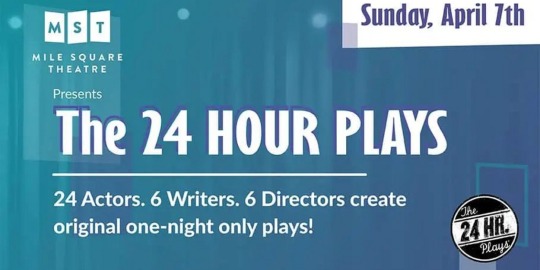
On April 7th, The 24 Hour Plays make their New Jersey debut at Hoboken's Mile Square Theatre. Established in 1995, The 24 Hour Plays are a non-profit theater company that bring creative communities together to write, rehearse and perform new plays and musicals in twenty-four hours.
“Mile Square Theatre and The 24 Hour Plays honor an abiding belief in the power of creative collaboration to develop transformative multicultural voices for the theater,” said Kevin R. Free, Artistic Director of Mile Square Theatre. “We're thrilled to be a partner to The 24 Hour Plays for its New Jersey premiere and host to a delightful mix of talents from New Jersey and New York City to make the program really sing.”
“The relationships artists build during formative theatre experiences like The 24 Hour Plays last their entire careers,” said producer Leo Layla Diaz. “We seek the very best cross-section of multi-generational and multi-cultural theater artists – and we arm them with what they need to hone their voices for this unique event."
Actors slated to participate include Gabriel Hernandez (Quarter Rican), Nirvaan Pal (School of Rock), Matt Lawler (“Station 11”, “Billions”), Kennedy Kanagawa (Into the Woods), Stephanie Kurtzuba (“The Irishman;” Wolf of Wall Street;” “Annie”), Joy Katharine Donze (Funny, Like an Abortion), DeAnna Supplee (B.R.O.K.E.N. code B.I.R.D switch.), Jason Yanto, Joelle Zazz, Maya Jeyam, Julia Way, Rich Frohman, David F. Gow (“The Girls on the Bus”), Jordan Ho, Grant Madison Stanton, Ross Cowan, Keivana Wallace (The Christmas Tree Farm) and Ian Lloyd Sanchez.
Writers include Susie Felber (Host/Producer "The Hawk"), DW Gregory (The Yellow Stocking Play, Radium Girls), Iraisa Ann Reilly (The Jersey Devil is a Papi Chulo), Pia Wilson (Black Bee), Marcus Scott (Sibling Rivalries), and Raakhee Mirchandani (JOURNEY TO THE STARS: KALPANA CHAWLA, ASTRONAUT). Directors include Julie Tucker, Rachel Dart (The Christmas Tree Farm) and Goldie Patrick (Paradise Blue). Musical Guests include Faye Chiao and Tasha Gordon-Solmon (Fountain of You). Additional artists to be announced.
Participating actors, writers, directors and production staff gather for the first time on the evening of Saturday, April 6th to introduce themselves and share prop and costume items they've been asked to bring. The writers will take inspiration from this meet and greet to write new plays overnight. In the morning, the actors and directors will receive the six new plays and team up with production staff to begin their rehearsal and tech process, with curtain at 7pm that night.
The 24 Hour Plays: Hoboken are produced by Leo Layla Diaz and Mark Armstrong in conjunction with Mile Square Theatre's Artistic Director Kevin R. Free. The event will honor the long-standing contributions of the Rostan Family to Mile Square Theatre with the dedication of the naming of the gallery space. Proceeds from The 24 Hour Plays: Hoboken will benefit Mile Square Theatre's non-profit theatre making and educational programming.
About The 24 Hour Plays
The 24 Hour Plays (est. 1995) bring together creative communities to produce plays and musicals written, rehearsed and performed in twenty-four hours. Through our radically present approach to theater, we make work that responds immediately to the world around us, builds communities and generates new artistic partnerships. Our events include The 24 Hour Plays on Broadway and The 24 Hour Musicals, as well as productions in Athens, Denver, Dublin, Finland, Florence, Germany, Little Rock, London, Los Angeles, Mexico City, Minneapolis, Philadelphia, Sacramento, San Francisco, Savannah and more. Beginning March 17 2020, The 24 Hour Plays Viral Monologues series generated over 600 new free-to-view theater pieces, featuring over 1000 artists, viewed millions of times worldwide and archived in the Library of Congress.
About Mile Square Theatre
Mile Square Theatre, a non-profit company, has been producing original and gently used theater since 2003 in Hoboken New Jersey. Located at 1400 Clinton Street in Hoboken, New Jersey, Mile Square Theatre enriches and engages the region through the year-round production and presentation of professional theatre and innovative arts education.
#marcus scott#marcusscott#write marcus#writemarcus#theater#theatre#playwrights#playwright#24hourplays#24hourplayshoboken
0 notes
Text
London
I had a stopover in London for a couple of days before coming home to Ireland for Christmas,
after nine months travelling throughout South America.
As I was in London the city was experiencing snow.
The snow didn’t exactly close the city but it sure restricted movement.
Businesses were closing early, footpaths and roads were potentially lethal.
Travelling throughout the UK was being ground to a halt, in terms of airports and trains.
The roads were still being gritted and were carrying on fine from what I saw.
I’d booked a train to get me to Holyhead, a ferry port in Wales, and a ferry ticket to get me across the Irish Sea to Dublin Port.
On the morning of 19 December I got myself to Euston Station to catch my train to Holyhead.
The snow changed my plans though.
I was able to get a seat on a later train after my one at 11.15 was cancelled.
The train I got was going to Liverpool.
I knew I’d have to change in Crewe, that was no problem, or so I thought.
Mindful of that many of the passengers were trying to catch a ferry the train company put on a bus service from Crewe to Holyhead as we would never have gotten to Holyhead if we’d have waited for the next train to Holyhead.
I got the last seat on the bus.
Off we went through the frozen countryside.
The bus was filled mainly with Irish people who were trying to get home.
Everyone on the bus had a story as to why they were travelling in such bad weather.
There were people going home to get married;
people going home after being to a funeral or going home to attend a funeral.
Many were just going home for Christmas.
The people on the bus reminded me of the queue in the doctors surgery,
nobody was there for the good of their health, if you know what I mean.
When we got to the ferry port in Holyhead we discovered that we were in time for the 17.30 ferry.
But, the ferry company didn’t think we’d make it and they’d sold our places to other people who were using the ferry because so many airports were shut on account of the frozen conditions.
We had to wait for the next ferry which wasn’t until 02.40. I sleep for the entire trip.
The ferry gets me into Dublin Port sometime after 06.00. I catch a bus and head home.
One last bus, well, I felt it was a good way to finish up after travelling all over South America using them!
0 notes